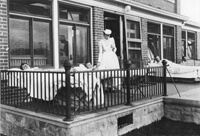Clinical History
Clinical History (1 of 3)
National Jewish Health* has a long and distinguished history in the treatment of respiratory, immunologic and related disorders. It all began in the late 19th century with a desire to provide treatment for a disease that was devastating the nation – tuberculosis (TB), or consumption as it was more commonly called.
Free Hospital for Indigent TB Victims
Denver’s dry and sunny climate had become famous throughout the country for its supposed beneficial effect on TB, which disproportionately affected poverty-stricken individuals. One of the first people to conceive of a free hospital for these indigent TB victims in Denver was Frances Wisebart Jacobs. She worked with the Jewish community to help create and fund National Jewish, which first opened its doors to patients in 1899. Although it was originally funded by the Jewish community, from its inception, the hospital’s services have never been limited to a specific religious denomination.
National Jewish was unique because it was the first institution in the United States to make treatment of indigent TB victims its primary goal.
The Early Years
 During the first 40 years of its existence, National Jewish was a tightly regulated institution where proper nourishment, outdoor exposure and adequate bed rest were staples of the TB treatment regimen. For the most severe cases, where the body failed to heal itself, additional treatment included surgery and lung collapse therapy (pneumothorax).
During the first 40 years of its existence, National Jewish was a tightly regulated institution where proper nourishment, outdoor exposure and adequate bed rest were staples of the TB treatment regimen. For the most severe cases, where the body failed to heal itself, additional treatment included surgery and lung collapse therapy (pneumothorax).
At the turn of the century, there was a strong belief in the therapeutic value of fresh air, so in the early years of the hospital, patients often slept on balconies outside their rooms to take advantage of the Colorado climate.
Typically, patients lived a quiet, dependent, sanatorium existence for three to five years. And in the latter part of their hospitalization, those patients who were getting better had the added bonus of rehabilitation, social and education programs. The education programs were intended to equip patients, who often came from lives of poverty, to function more effectively in the world outside of the hospital.
The B'nai B'rith Infirmary Is Built to Help More Patients
In 1921, the death rate nationally from TB was 99 per 100,000, or nearly one out of every 1,000 people. Yet there were only 58,000 beds in TB hospitals and sanitoriums. Because of the bed shortage, many of the 106,000 deaths each year occurred at home. This crisis prompted National Jewish administrators to start fundraising to build the B'nai B'rith Building.
At the hospital's 1924 annual meeting, President William B. Woolner donated the first $5,000 to launch the fundraising campaign for the new building, inspiring delegates to dig deep into the pockets of B'nai B'rith chapters nationwide. Two B'nai B'rith district lodges made the largest donation of $350,000.
Before the infirmary was built, National Jewish treated 213 inpatients a year in its 185 beds with each patient staying an average of seven months. The hospital also treated 117 outpatients, for a total of 330 patients. By 1924, National Jewish had treated 4,511 patients since it opened its doors. Of these, 2,200 were Russian immigrants. The next three countries of non-U.S. origin were Austria (244 patients), Romania (180), and Hungary (157).
In 1924, the National Jewish budget was $286,955 and the campus consisted of 12 buildings.
The cornerstone for the B'nai B'rith Building was laid in 1925. Costing more than $500,000, the building was highly advanced for its time. Facilities included operating, consulting and diagnostic rooms; heliotherapy, X-ray, fluoroscope and drug departments; and 100 private rooms equipped with open-air sleeping porches. Its medical facilities made possible the treatment of all stages of tuberculosis.
Engraved over the doorway of the four-story stone structure was the now-famous motto: "None may enter who can pay, none can pay who enter."
In 1926, after the B'nai B'rith Building was ready for patients, National Jewish had an additional 100 patient beds, for a total of 285 beds. When the new building was dedicated, more than 300 people were waiting to be admitted to National Jewish.
Children in the Preventorium
Malnutrition, poverty and overcrowding in city slums were the main culprits leading to contracting TB. Therefore, when the preventorium concept gained popularity in the country, National Jewish seemed a logical place to house well but impoverished children so they could get medically-supervised food and exercise. (A preventorium was a place where people who were likely to get sick were sent to receive preventive care.)
The Hofheimer Preventorium at National Jewish was built and opened in 1920. The facility, while designated to keep well children healthy, also treated children with TB of the bone, joints and similar afflictions. Some of the young patients stayed at the institution for three or four years. The preventorium was closed in 1942, yet in its 22 years of existence it cared for 730 children.
NEXT: Holistic treatment and Expansion of Services
Page 1, 2, 3
*Over the years, the National Jewish Health name has evolved to better communicate our mission. However, all names have included a common component –the words National Jewish. Therefore, the name National Jewish is used in all references to our institution throughout this history overview.
